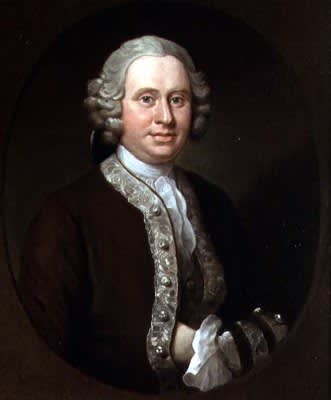
William Hogarth
To view all current artworks for sale visit philipmould.com
Of William FitzHerbert, Samuel Johnson said,
I never knew a man who was so generally acceptable. He made everybody quite easy, overpowered nobody by the superiority of his talents, made no man think worse of himself by being his rival, seemed always to listen, did not oppose what you said.
Although Johnson, the greatest social critic of the period, acknowledges that there was neither brilliancy nor sparkle in FitzHerbert, he effectively establishes the tone for his life and career. FitzHerbert was the eldest son of William FitzHerbert of Tissington Hall by Rachel, daughter and heiress of Thomas Bagshaw of Bakewell, Derbyshire and grand-daughter of Thomas Alleyne of Barbados. He was educated at Derby and Emmanuel College, Cambridge before he joined the Inner Temple and was called to the Bar in 1739. He married on 23 June 1744, Mary, eldest daughter of Littleton Poyntz Meynell of Bradley, Derbyshire. Of his five sons, William was a Gentleman-usher to George III and was created a Baronet. Alleyne, the youngest son, a distinguished politician and diplomat was raised to the Irish peerage as Baron of St. Helen's.
Coming from an important landowning Derbyshire family, William FitzHerbert was a figure of considerable influence in both local and London political circles. The FitzHerbert family was closely associated with that of the Cavendishes from Chatsworth, who at that time were probably the most important family in the county. Tissington Hall (which the FitzHerbert family still own today) was essentially a Jacobean house and William FitzHerbert under the influence of Horace Walpole's house at Strawberry Hill, transformed the entrance hall into a magnificent Gothic room, as well as altering several other rooms in the same style.
In January 1754 FitzHerbert applied to stand as Member of Parliament for Derby, a seat held by his close friend William Cavendish, Marquis of Hartington and later fourth Duke of Devonshire, whose celebrated portrait by Hogarth dates from the same period.
However, FitzHerbert had to wait until 1761 to enter Parliament, which he did as Member for Bramber (and later for Derby), supported by Devonshire and the Duke of Newcastle. He was appointed by the Rockingham administration to the Board of Trade and took his duties very seriously, intensified by personal interests in the West Indies. In 1765 it was strongly rumoured that he was going to be the next Governor of Barbados but it is not known whether he was offered the appointment. He worked with Rockingham and Grafton to arrange for Wilkes's pardon and return to England.
Hogarth's portrait of William Fitzherbert appears to date from the early 1740s and it was apparently part of a husband and wife pair. A portrait of Mrs Mary Fitzherbert by Hogarth is recorded in 1911 as in the possession of Sir H. M. Fitzherbert and was shown in a loan exhibition of Old Masters at the Grafton Gallery. The portrait of William Fitzherbert is recorded by Sir George Scharf as being in the Collection of Mr Henry Farrer on December 3rd, 1863. (7)
Provenance: Almost certainly the sitter, William Fitzherbert 1863, The Farrer Collection (recorded by Scharf)
1 James Boswell, The Life of Samuel Johnson LL.D. Vol. iii, p. 134.
2 Cavendish's Debates, Egerton 217, ff.347-9.
3 Grenville mss (JM).
4 R. Paulson, Hogarth: His Life, Art and Times. 1971, Vol. 2, p. 303.
5 Op.cit. 1.
6 J. L. Smith-Dampier, Who's Who in Boswell?, 1935, p. 127.
7 Trustees Sketch Book, Volume VIII, p. 39. National Portrait Gallery Archives, Lewisham.